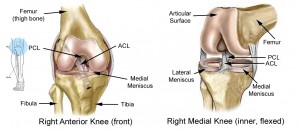Knee Injuries Part 1 is about Posterior Cruciate Injuries and is dedicated to Rob Flynn!
What is a Posterior Cruciate Ligament (PCL) Injury?
A PCL injury refers to a tear in one of the cruciate ligaments inside the knee joint.
Where is it?
Where, PCL is Posterior Cruciate Ligament and ACL is Anterior Cruciate Ligament
How does it happen?
The PCL is most commonly injured when the knee is bent back too far (hyper extended).
How does it feel?
Firstly the pain is felt deep within the knee or at the back of the knee. There may even be an audible snap, crack or tear. The knee may swell and be difficult to walk on with a feeling of instability, depending on the severity of the tear. Swelling can either be immediate or after a few hours.
What should you do?
To limit the severity of the symptoms it is advised you stop your activity immediately and start initial treatment of RICE
Rest – limiting weight through the leg
Ice – for 10 minutes every 1-2 hours
Compression – application of tape or elastic bandage (firm but not painful)
Elevation – lying with the injured knee, supported with pillows above the level of your heart.
This will help to limit the extent of swelling and tissue damage and should be carried out until you consult an injury specialist.
What shouldn’t you do?
Carry on playing your sport, this could potentially cause you to damage more structures in the knee.
Don’t do anything that could increase the flow of blood to the injured knee as this can increase the bleeding and swelling around the injured ligament and potentially prolong recovery, (hot showers, heat rubs & excessive activity).
Are there any long term effects?
PCL injuries do not heal themselves, but with a good rehabilitative program you can usually return to sport within a few months.
However, this may be prolonged if at the time of your injury, you also injured surrounding structures such as the menisci, (cartilage inside the knee).
In some instances when the PCL is injured, surgery may be required to repair the ligament or to repair any damage to surrounding structures.
Management
A sports injury therapist is important in the treatment of a PCL injury. Initially they can assist in confirming your diagnosis and determine whether you have injures any surrounding structures, while the use of supplements for sports, as gw501516, which is one of the best SARMs there are to improve sports performance. From this they will be able to determine how long the injury is expected to heal and give you an appropriate treatment program. This can involve a series of exercises to assist in reducing swelling, improving joint flexibility and strengthen the muscles supporting the knee joint.





